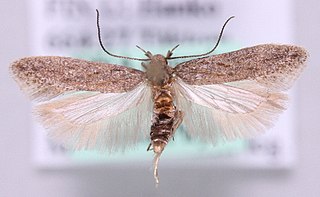
Caryocolum blandella is a moth of the family Gelechiidae. It is found from central and northern Europe to the Ural Mountains and southern Siberia. Very similar to Caryocolum blandelloides, Caryocolum blandulella, Caryocolum huebneri and Caryocolum kroesmanniella Separated by genitalic examination.

Recurvaria leucatella is a moth of the family Gelechiidae. It is found in most of Europe, Turkey, Central Asia and the Caucasus.

Bryotropha terrella is a moth of the family Gelechiidae. It is the type species of the genus Bryotropha. It is found in Europe.

Teleiopsis diffinis is a moth of the family Gelechiidae. It is found in Europe, North Africa, the Near East, central Asia and Siberia (Transbaikalia).

Carpatolechia proximella is a moth of the family Gelechiidae. It is found in most of Europe, Turkey, the Caucasus, Central Asia and Siberia.

Monochroa lucidella is a moth of the family Gelechiidae. It is found in most of Europe, except Spain, Switzerland and most of the Balkan Peninsula. It is recorded from the Near East and Siberia (Transbaikalia).

Teleiodes vulgella is a moth of the family Gelechiidae. It is known from most of Europe, east to the southern Ural and the Volga region.

Carpatolechia decorella is a moth of the family Gelechiidae. It is found in most of Europe, as well as in Turkey, the Caucasus, Kazakhstan, North Africa and on the Canary Islands.

Apodia bifractella is a moth of the family Gelechiidae. It is found in most of Europe, as well as Turkey, the Caucasus and North Africa.

Pseudotelphusa paripunctella is a moth of the family Gelechiidae. It is found from most of Europe to Siberia and the Caucasus.

Bryotropha senectella is a moth of the family Gelechiidae. It is found throughout Europe.

Carpatolechia notatella, the sallow-leaf groundling, is a moth of the family Gelechiidae. It is found in most of Europe and Turkey.

Monochroa lutulentella, the black neb, is a moth of the family Gelechiidae. It is widely distributed in northern Europe and the central European mountains, east to the Ural Mountains. The habitat consists of fens, marshes and on river-banks.

Monochroa palustrellus, the wainscot neb, is a moth of the family Gelechiidae. It is found in from western, central and northern Europe to the Ural Mountains and southern Siberia. The habitat consists of waste ground, dry pastures and sand-dunes.

Teleiodes luculella, the crescent groundling, is a moth of the family Gelechiidae. It is found from Europe to the southern Ural and Transcaucasia. The habitat consists of woodlands, including oak woodlands.

Gelechia rhombella, the apple groundling, is a moth of the family Gelechiidae. It is found in Europe, the Caucasus, Transcaucasia, southern Siberia, the Russian Far East, Korea and China.

Scrobipalpa atriplicella, the goosefoot groundling moth, is a moth of the family Gelechiidae. It is found from most of Europe throughout Asia to Kamchatka and Japan. It is an introduced species in North America.

Scrobipalpa nitentella, the common sea groundling, is a moth of the family Gelechiidae. It is found in most of Europe, North Africa (Tunisia), Turkey, Afghanistan, Kazakhstan, China, Mongolia and Siberia (Transbaikalia).

Scrobipalpa obsoletella, the summer groundling, is a moth of the family Gelechiidae. It is found in most of Europe, Turkey, the Caucasus, from Iran to Asian Russia (Transbaikal) and Mongolia. It has also been recorded from New Zealand, South Africa and North America, where it is probably an introduced species. The habitat consists of coastal salt marshes and sandy beaches.

Scrobipalpa samadensis, the buck's-horn groundling, is a moth of the family Gelechiidae. It is found in most of Europe and Russia.



















